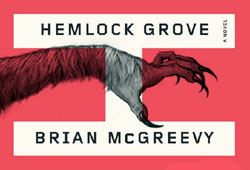
Werewolves, vampires, and mad scientists are all staples of the supernatural, while the steel industry of the past and present-day transformation into a technological hub are synonymous with Pittsburgh. In his 2012 debut novel Hemlock Grove, Pennsylvania native Brian McGreevy weaves these disparate elements together into a homage of Bram Stoker and Mary Shelley, turning the once Steel City into an East Coast equivalent of Twin Peaks in the process.
The title refers to a fictitious suburb of Pittsburgh, a small town built on the strength of the steel industry that has reimagined itself as a hotbed of biotechnology in the twenty-first century. Peter Rumancek is the new kid in town, and also the werewolf of the story. A half-breed gypsy by birth, Rumancek and his mother moved into a trailer park in Hemlock Grove after the death of a distant cousin. Peter immediately became a social outcast, both because of his lineage and by intentional design – he would rather be alone than popular, mainly because of the transformation that he goes through once a month.
He makes the mistake, however, of admitting that he is a werewolf to a fellow high school student named Christina Wendall, who immediately suspects Rumancek is responsible for the death of a teenage girl found brutally savaged by an unknown animal and is not afraid to tell others of her suspicions.
Fearing that he will be arrested for a crime he did not commit – especially when a second dead girl is found the following month during another full moon – Rumancek agrees to an uneasy alliance with Roman Godfrey, the seventeen-year-old heir of the Godfrey family that owned the original steel mills in Hemlock Grove and the subsequent biomedical facility known as the White Tower. It is an uneasy alliance not just because of the class differences between the two but because Rumancek senses that Godfrey is an upyr, a form of vampire that can walk in sunlight.
It turns out that Roman is just the tip of the Godfrey supernatural iceberg. His mother Olivia is also a force (of evil?) to be reckoned with, the widow of family patriarch J.R. Godfrey who transformed the local economy from steel to biotechnology. Sister Shelley, meanwhile, is a genetic experiment gone awry, turning the once dead girl into a mute giant.
Cousin Letha appears the most normal, until it is revealed that the self-proclaimed virgin has been impregnated by an angel. Her father Norman Godfrey, on the other hand, actually is as normal as anyone can be in Hemlock Grove but struggles with his teenage daughter’s unexplained pregnancy – as well as her later romantic involvement with werewolf Peter Rumancek – his own off-again, on-again affair with Olivia Godfrey, and his opposition to resident “mad scientist” Dr. Johann Pryce, who runs the White Tower medical institute.
Author Brian McGreevy has woven together the traditional elements of science fiction and horror into a grand soap opera of epic proportions, with a murder mystery thrown in for good measure. Hemlock Grove is no Twilight-like love story, however, but a detailed homage to everything from Mary Shelley’s Frankenstein to Bram Stoker’s Dracula. Its Twin Peaks influences, meanwhile, go beyond the “Who Killed Laura Palmer?” tagline to encompass an entire town of eccentrics across all social and economic class divides, expertly melded together into the perfect blend of horror and suspense.
Pittsburgh itself is directly mentioned throughout the novel – with side trips to Shadyside and the Hot Metal Bridge, as well as the occasional comment regarding the Pittsburgh Steelers – but it is the indirect references to the Steel City that are most intriguing.
“Actually, the town ends up being a sort of Through the Looking Glass version of Pittsburgh,” Brian McGreevy told GQ Magazine in March 2012. “The economic history of the town reflects the economic history of Pittsburgh, which did transition from heavy misery into healthcare and biotechnology, and does have a fairly significant class divide, which is really exhibited with the two protagonists, Peter and Roman. In Pittsburgh traditionally, the poorer you were, the closer you lived to the river, and the further you were in upper management, the higher you were on the hill. And there was actually an equalizer after that because the highest thing on the hill was the cemetery.”
Even the White Tower and scientific experiments of Dr. Johann Pryce in Hemlock Grove have their origins within the city of Pittsburgh. “There’s a very important location in the story, a biomedical tower,” McGreevy explained to the Pittsburgh Tribune Review. “These different and potentially unseemly experiments are happening. The direct inspiration for that was my undergraduate experience at Pitt, where I learned that stray dogs were being killed and medically brought back to life at the UPMC biomedical tower, and thought that was the craziest thing I’d ever heard. I couldn’t believe that that kind of stuff was happening in our backyard, in Pittsburgh.”
The Godfreys may never be confused with the Carnegies or Mellons, but Hemlock Grove is a fitting addition to the fictional lore of the Steel City nonetheless. Just like George Romero took the traditional elements of Haitian voodoo legend and crafted a new zombie mythology, Brian McGreevy has incorporated such classic horror narratives as Frankenstein, Dracula, The Wolf Man, and Dr. Jekyll and Mr. Hyde into his own contemporary version of the supernatural – making the small town of Hemlock Grove a new icon to stand alongside Evans City within the realm of Pittsburgh horror and fantasy.
Anthony Letizia

